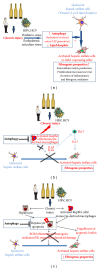Autophagy: a multifaceted partner in liver fibrosis
- PMID: 25254217
- PMCID: PMC4164803
- DOI: 10.1155/2014/869390
Autophagy: a multifaceted partner in liver fibrosis
Abstract
Liver fibrosis is a common wound healing response to chronic liver injury of all causes, and its end-stage cirrhosis is responsible for high morbidity and mortality worldwide. Fibrosis results from prolonged parenchymal cell apoptosis and necrosis associated with an inflammatory reaction that leads to recruitment of immune cells, activation and accumulation of fibrogenic cells, and extracellular matrix accumulation. The fibrogenic process is driven by hepatic myofibroblasts, that mainly derive from hepatic stellate cells undergoing a transdifferentiation from a quiescent, lipid-rich into a fibrogenic myofibroblastic phenotype, in response to paracrine/autocrine signals produced by neighbouring inflammatory and parenchymal cells. Autophagy is an important regulator of liver homeostasis under physiological and pathological conditions. This review focuses on recent findings showing that autophagy is a novel, but complex, regulatory pathway in liver fibrosis, with profibrogenic effects relying on its direct contribution to the process of hepatic stellate cell activation, but with antifibrogenic properties via indirect hepatoprotective and anti-inflammatory properties. Therefore, cell-specific delivery of drugs that exploit autophagic pathways is a prerequisite to further consider autophagy as a potential target for antifibrotic therapy.
Figures


References
-
- Lotersztajn S, Julien B, Teixeira-Clerc F, Grenard P, Mallat A. Hepatic fibrosis: molecular mechanisms and drug targets. Annual Review of Pharmacology and Toxicology. 2005;45:605–628. - PubMed
-
- Mallat A, Lotersztajn S. Cellular mechanisms of tissue fibrosis. 5. Novel insights into liver fibrosis. American Journal of Physiology. 2013;305(8):C789–C799. - PubMed
-
- Boya P, Codogno P. Micronucleophagy: a new mechanism to protect against chromosomal instability? Cell Cycle. 2012;11(4):645–646. - PubMed
-
- Mizushima N, Yoshimori T, Ohsumi Y. The role of atg proteins in autophagosome formation. Annual Review of Cell and Developmental Biology. 2011;27:107–132. - PubMed
Publication types
MeSH terms
Substances
LinkOut - more resources
Full Text Sources
Other Literature Sources
Medical

